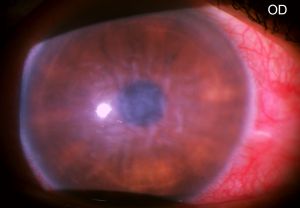Milkweed Corneal Toxicity
All content on Eyewiki is protected by copyright law and the Terms of Service. This content may not be reproduced, copied, or put into any artificial intelligence program, including large language and generative AI models, without permission from the Academy.
Disease Entity
Disease
Plants in the Asclepias family, known colloquially as “Milkweed” plants due to their milky sap, are commonly found in household gardens because of their colorful, ornate, flowers and role in the lifecycle of monarch butterflies[1]. Unsuspecting gardeners and children have been known to touch the sap, called latex, and suffer from toxic side effects. Contact with ocular structures leads to an inflammatory response with concurrent corneal edema.
Pathophysiology
Milkweed plants produce Carnenolides, which are cardiac glycosides akin to Digitalis capable of binding to Sodium/Potassium ATPases (Na+/K+-ATPases). As a result, direct ocular exposure can inhibit corneal pump function with resultant corneal edema and ocular irritation.
Diagnosis
Diagnosis of Milkweed corneal toxicity is clinical. Patients, particularly children, may or may not make the connection between plant exposure and onset of symptoms. Thus, a high index of suspicion is needed when obtaining a history and examining patients. The clinical exam is defined by conjunctival injection, corneal edema, and Descemet folds[2][3]. Intra-ocular pressure is typically normal. Signs of severe ocular toxicity such as perilimbal whitening, anterior uveitis, and symblepharon are not typical. Specular microscopy and pachymetry can help in the diagnosis of endothelial toxicity.
Differential diagnosis
One must consider any condition that can cause corneal edema and conjunctival injection:
- Viral Conjunctivitis
- Herpes keratitis
- Trauma
- Acid or Base Related Chemical Keratitis
- Acute Angle Closure Glaucoma
- Anterior Uveitis
Management
Like any ophthalmic chemical exposure, removing the offending agent and ensuring anterior segment stabilization is important. Prompt ocular irrigation with saline solution and measurement of ocular pH is advisable. Interestingly, in-vitro studies have demonstrated a direct benefit to treatment with topical dexamethasone as it is able to up-regulate Na+/K+-ATPase activity in the corneal endothelium and expedite corneal recovery[4]. Concurrent use of a hypertonic agent, such as 5% sodium chloride, can also decrease corneal edema via an osmotic effect. Patient should be monitored closely with daily exams until clinically stabilized. Fortunately, most patients recover in a matter of days with no residual sequela.
Conclusion
Milkweed exposure is an important clinical entity that causes significant ocular toxicity that, with appropriate anterior segment stabilization and topical steroids/osmotic agents, can be managed effectively by eye providers. A high index of suspicion is needed to make this diagnosis and clinicians should be careful to exclude more common, vision-threatening etiologies. Use of protective goggles and health education can prevent such ocular toxicity.
References
- ↑ Agrawal, Anurag (2017-03-07). Monarchs and Milkweed: A Migrating Butterfly, a Poisonous Plant, and Their Remarkable Story of Coevolution. Princeton University Press. ISBN 9781400884766.[1]
- ↑ Amiran MD, Lang Y, Yeung SN. Corneal endothelial toxicity secondary to Asclepias fruticosa. Eye (Lond). 2011;25(7):961-3.[2]
- ↑ Chakraborty S, Siegenthaler J, Buchi ER. Corneal edema due to Asclepiascurassavica. Arch Ophthalmol. 1995;113:974–975.[3]
- ↑ Hatou S, Yamada M, Mochizuki H, Shiraishi A, Joko T, Nishida T. The effects of dexamethasone on the Na,K-ATPase activity and pump function of corneal endothelial cells. Curr Eye Res. 2009;34(5):347-54.[4]


